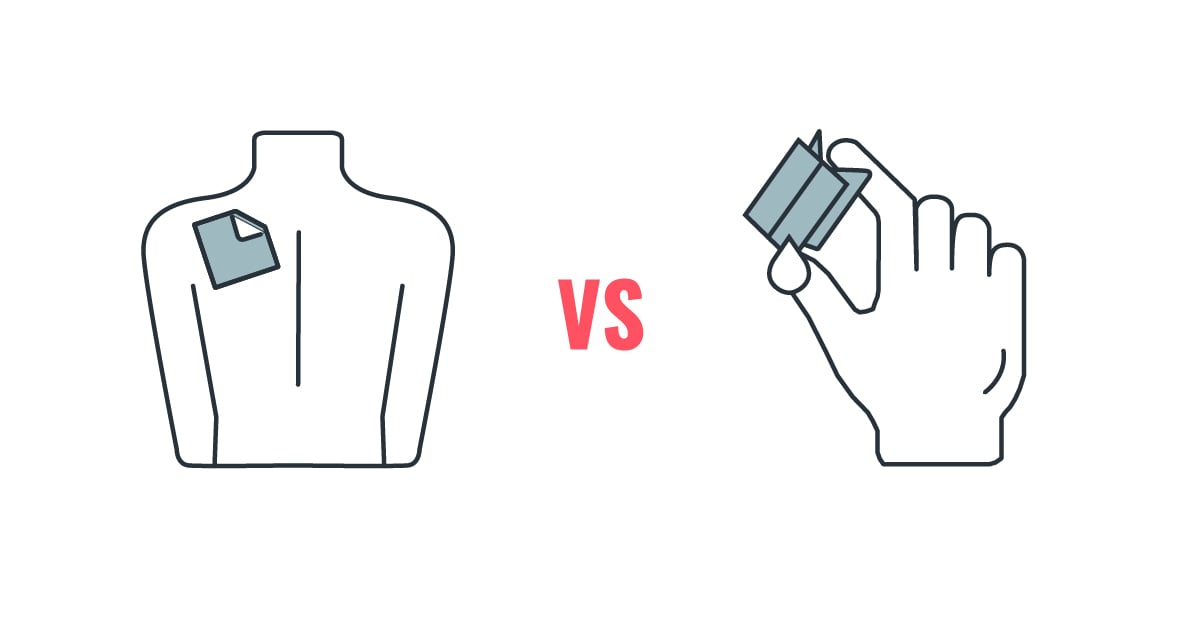Because topical and transdermal treatments are both applied directly to the skin, it’s easy to confuse the two. However, these two treatment systems affect the human body in very different ways.
Topical treatments consist of gels and creams that work at or near the skin’s surface. They’re only effective on the surface of the skin where they’re applied. Transdermal treatments, on the other hand, steadily deliver their Active Pharmaceutical Ingredients (APIs) into the bloodstream so that they can be effective throughout the body.
Common topical treatments include sunscreens, antiseptics, and insect repellents. Common transdermal treatments include smoking cessation patches, hormone patches, and treatments for more severe conditions.

TOPICAL MEDICATION VS. TRANSDERMAL MEDICATION
While transdermal medications are most commonly delivered by patch, some creams and gels are also designed to deliver APIs transdermally. In addition to pain relief treatments, transdermal gels are also frequently used in veterinary medicine.
However, topical and transdermal creams and gels have a few drawbacks: they’re messy, their ingredients can be transferred easily to other areas of the skin, and they’re difficult to apply in a precise dose. Tapemark’s proprietary Snap and Snapplicator delivery systems eliminate these issues and can easily deliver semi-solid formulations that require greater precision and control. They’re also sanitary, portable, predictable, safe, and extremely easy to use.
Tapemark’s Snap and Snapplicator designs have been especially helpful in designing beauty treatments, as well as treating conditions like fungal infections, itch, and dermatitis.
ABSORPTION RATES
Human skin contains three layers: the epidermis (top layer), the dermis (middle layer), and the hypodermis (bottom layer). While each layer has different specific functions, overall, the skin is designed to keep most external elements out and protect the body’s internal tissue. While the skin is an effective barrier against UV radiation, bacteria, viruses, and many chemicals, some chemicals and APIs can be absorbed through the skin, and ultimately, enter the bloodstream.
Patients should follow their doctor’s instructions when using topical or transdermal treatments, as absorption can be affected by many factors:
- Skin thickness in the area of application
- Skin temperature
- Skin integrity
- Skin hydration
- Skin metabolism
- API properties, including molecule size
- API concentration
- Length of time an API remains in contact with the skin
- The amount of skin that is exposed to APIs
HOW NEW TRANSDERMAL TECHNOLOGIES CAN INCREASE ABSORPTION RATES
While transdermal treatments offer many advantages over pills and injections, not all APIs are easily absorbed into the bloodstream through the skin. However, new transdermal patch designs are increasing the number of APIs that can be delivered by patch.
In addition to chemical permeation enhancers, some transdermal patches have also enhanced permeability by applying a low electrical current (iontophoresis), using microneedle technology, or a combination of these technologies. Tapemark’s proprietary designs are vastly expanding the number of drugs that can be delivered transdermally. These designs include the IontoPatch, as well as the MacroPerm and MicroDerm patches.
IONTOPATCH
The IontoPatch is Tapemark’s proprietary iontophoresis patch. Unlike other patches that use electrical current to boost absorption, the IontoPatch doesn’t need charging stations, dose controllers, or active monitoring. Instead, it can be worn on the go and over areas that require more freedom of movement, like elbows, knees, wrists, feet, and shoulders.
MACROPERM
While molecule size remains a challenge for transdermal delivery, Tapemark’s MacroPerm patch can deliver APIs up to 25,000 daltons — a size that was previously considered to be impossible to deliver through transdermal patches. Additionally, the MacroPerm patch offers ten times more bioavailability and reduces side effects fivefold.
MICRODERM
The MicroDerm patch combines 100 – 2,000 microneedles on a single patch to penetrate the skin just enough to boost absorption without the discomfort of hypodermic needles. In the future, MicroDerm patches will be able to provide safe alternatives to many treatments now delivered by injection, like vaccines, insulin, proteins and peptides, biologics, and other large molecule APIs.
HOW TO DEVELOP NEW TOPICAL AND TRANSDERMAL THERAPIES
The market for new transdermal treatments is growing significantly as more consumers become aware of the many advantages of transdermal treatments, and providers and insurers see significant improvements in patient compliance and long-term results.
Investing in new topical and transdermal therapies, however, is not without its challenges. To learn more about recent innovations in transdermal patch designs and how to scale from lab production to mass production, Tapemark’s eBook: From One to One Million, is free to download. Additionally, answers to frequently asked questions about partnering with a Contract Development and Manufacturing Organization (CDMO) are available here.
